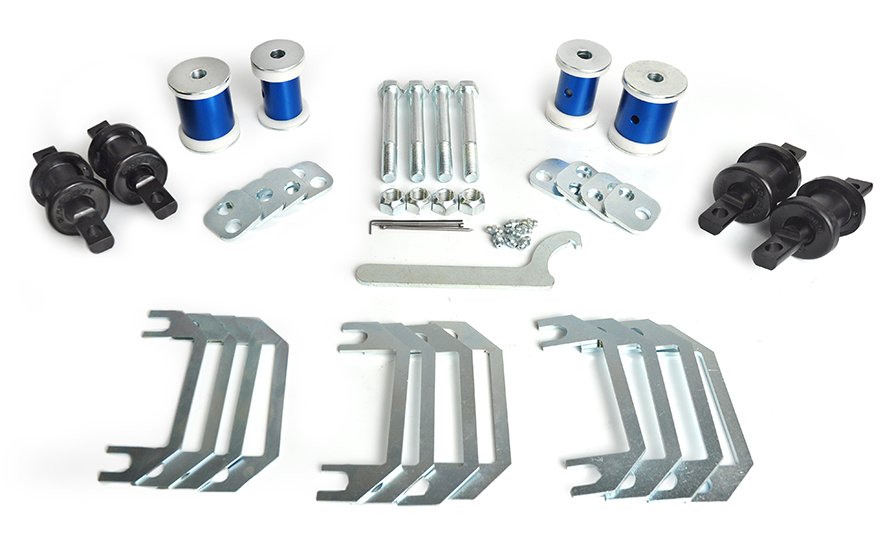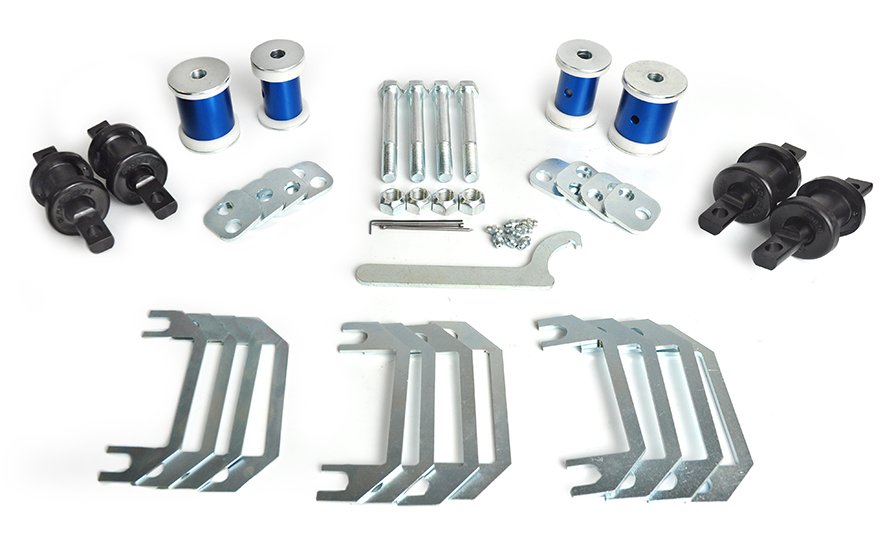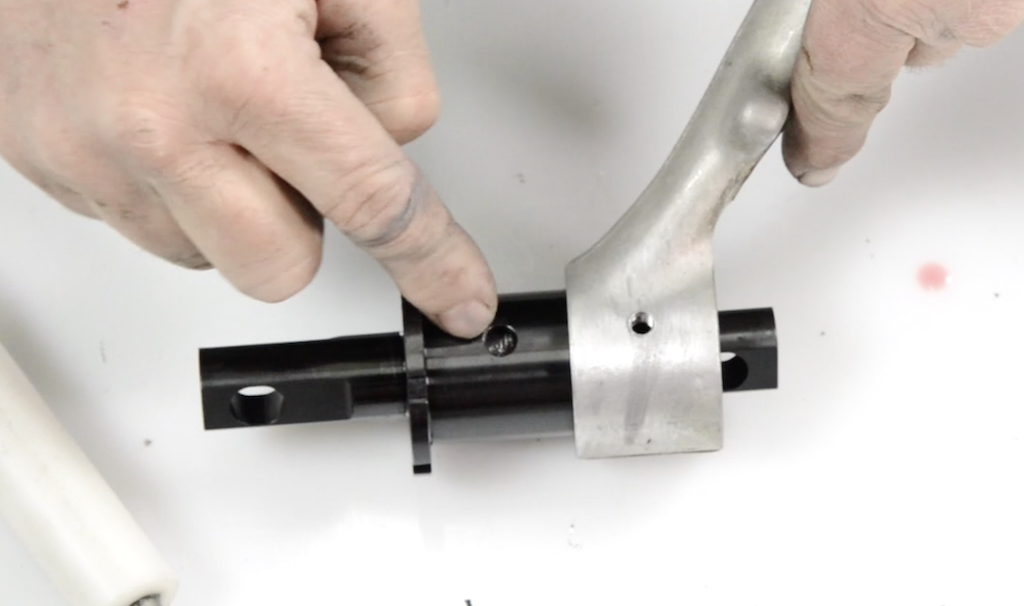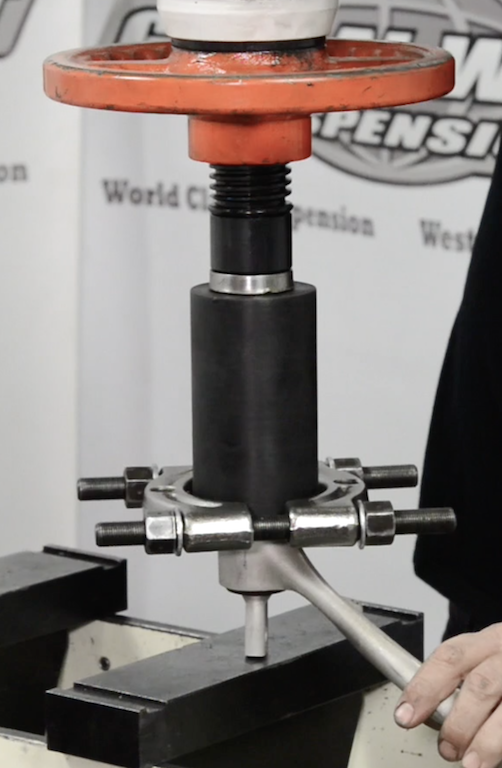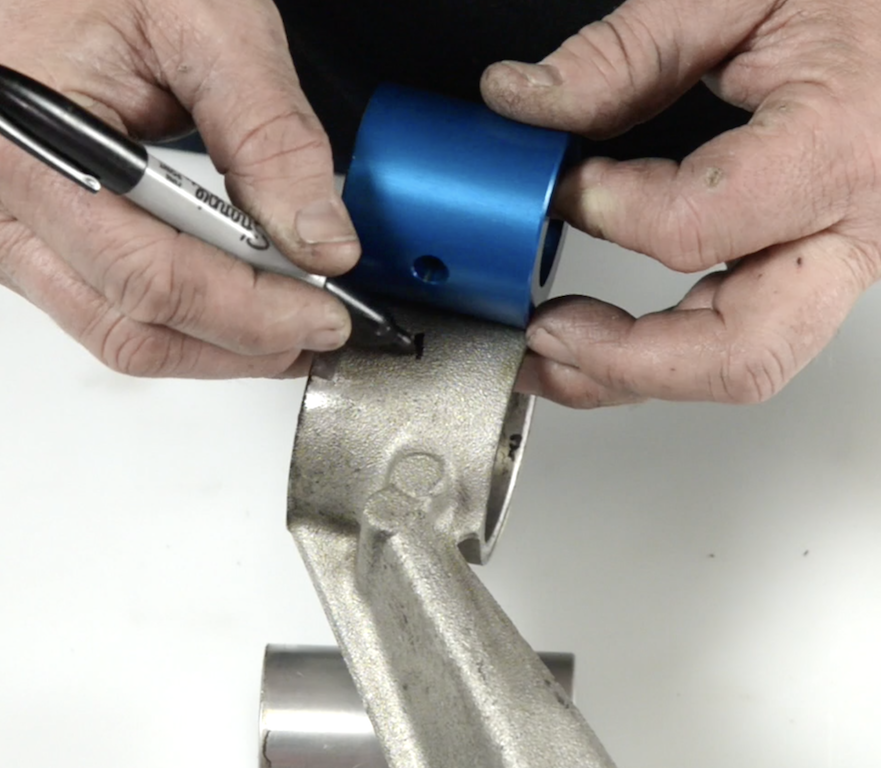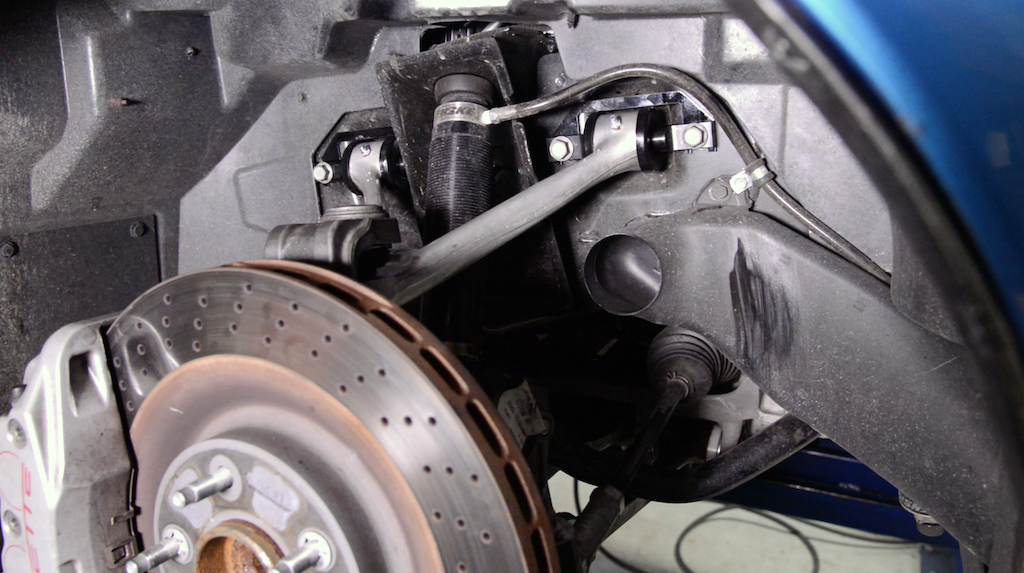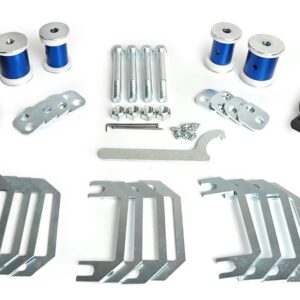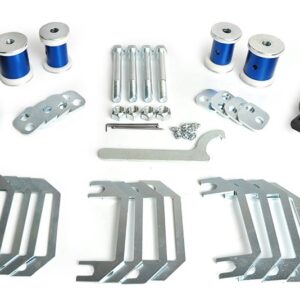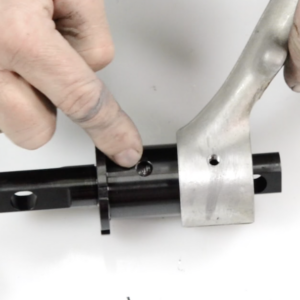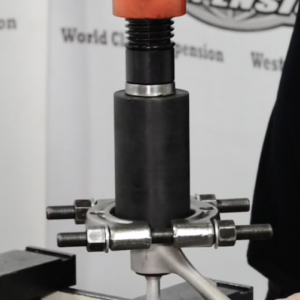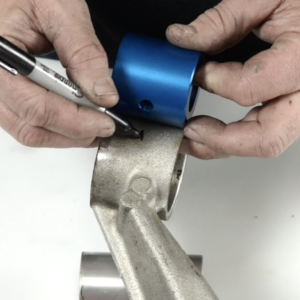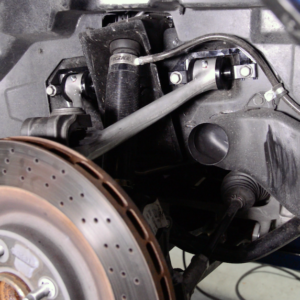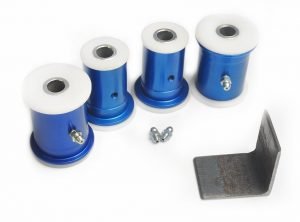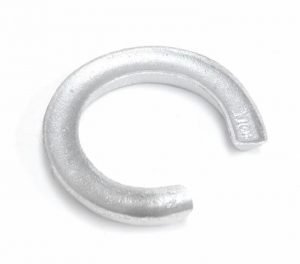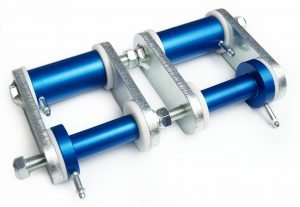Description
Kit includes:
- 4 – Upper ball shaft pivot assemblies — assembled
- 4 – Del-a-lum lower bushing assemblies
- 1 – LOC-56 lock out kit includes hardware
- 1 – SMK-56 alignment shim kit
- 1 – Spanner wrench
- 16 – Set screws
- 2 – Center punches
- 1 – Allen wrench
Corvettes from 1997 through 2013 commonly known as C5 and C6 models have inherently had suspension bushing problems, especially if the car has been auto crossed or road raced. The common complaint is the upper and lower control arms literally slide off the bushings when put to the test (hard cornering). GM designed their upper arm shafts with a large flat surface towards the outside of the arm to give the bushing something to ride up against. But in the performance world this really is not enough to get the control you need over the suspension and alignment. As for the lower arm, it just shifts towards the rear of the car and stops at the cross member. For street applications this will take a little time to develop but honestly even on the street it would be nice to have better control.
Photo below
GM suggested shimming the upper shaft against the bushing in order to help support the bushings.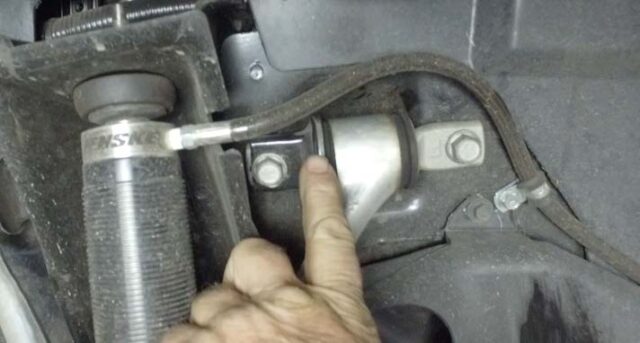
The concept makes sense; it just doesn’t work very well.
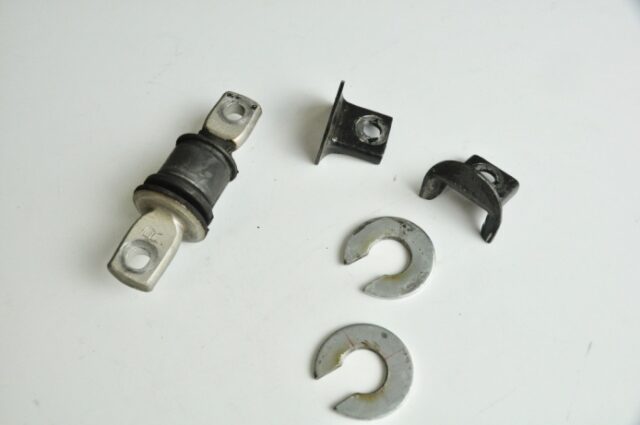 Photo to the left shows the added GM bushing support and a washer cut to take up the air gap between the GM bushing support and the bushing face. The washer was another attempt to reduce control arm fore and aft movement.
Photo to the left shows the added GM bushing support and a washer cut to take up the air gap between the GM bushing support and the bushing face. The washer was another attempt to reduce control arm fore and aft movement.
The lower control arm has its own set of issues. We tested the C-6 bushings with our durometer gauge and they only read 60. The rubber durometer is pretty soft. During cornering the lower control arm experiences substantial deflection fore and aft do to the low bushing durometer. The deflection directly affects the alignment. Eventually the control arm shifts on the bushing which constantly causes the alignment to change. In the photo below you can see the lower arm shifted towards the rear of the car. This happened over a short period of time on an autocross track. On the street it will take a little longer to generate but the condition will eventually happen. This explains why when a Corvette starts to follow the road (hunt) or not hold an alignment, the bushings have worn out.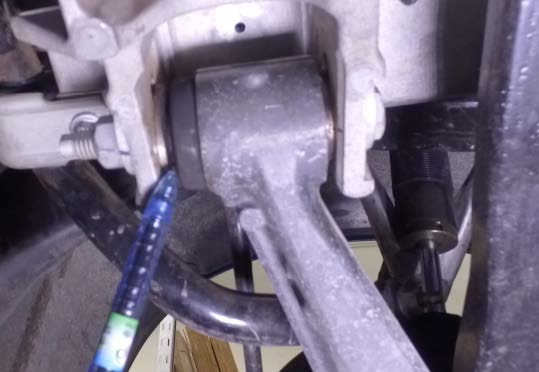
So what is the fix?
Kit — KT-C56F provides answers to the problem. Del-a-lum bushings for the lowers and special ball shaft upper mounts that work like a spherical bearing for the upper arms. This kit also changes the way you align the car. Instead of the alignment being set with eccentrics on the lower arm, it will now be done on the upper with shims. This is beneficial because eccentrics can slip causing your alignment to change. Moving to a shim application on the upper arm eliminates the problem.
Let’s start with the lower:
Del-a-lum bushings are used for the lower arms. The bushings are a direct replacement, they simply press into the lower arms replacing the stock rubber components. (See install video) Del-a-lum bushings work on 6 surfaces, four located at the thrust washers and 2 in the bushing housing.
The bushing work like a bearing with plastic internal components acting as a form of isolation from metal to metal. They are lubricated via grease fitting and provide smooth up and down movement. Del-a-lum bushings stop the lower arm from moving fore and aft which is way your car would follow the road or hunt.
In order to use Del-a-lum bushings in the lower control arms we must remove the eccentrics the factory use. Anytime you use a solid type bushing whether it is made out of aluminum, steel, or plastic, the arm must pivot on the same center line. If not the lower arm will go into bind. We supply a kit part number LOC- 56 with this package. LOC-56 replaces the eccentrics and locates the lower arm bushings in the cross member so they remain on center line.
(Photo of plates kit LOC-56)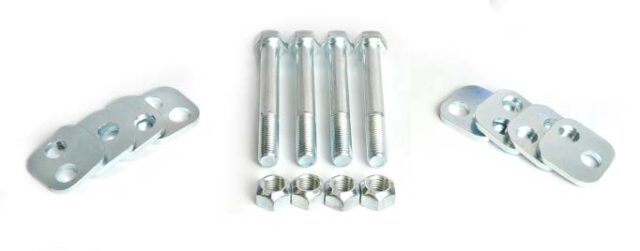
The LOC-56 has 8 special plates and 14mm hardware for removing the eccentrics. The plates have a couple of holes pre drilled in them for setting the position of the arm. This actually provides 3 settings which is more than enough for alignment because the upper arm is going to set the alignment. The two holes in the lower are just for establishing what range of camber that you what to align in. For example positioning the hole in plate on the cross member all the way to the outside of the car will give you the most negative camber. This would be used for auto cross or road racing. The center hole in the plate would be for street or drag applications. Flipping the plates around so the arm would be the most inward would provide more positive camber (normally not used).
Installing lower arm bushings is fairly easy. See video.
Upper control arm bushing/shaft assemblies:
The upper arm uses two upper shafts because the cross member support for the shock goes in between the arm. Adjusting the alignment on the upper control arm will require something special regarding the bushing being used in the control arm. Alignment shims are now going to be used so solid bushings like our Del-a-lum bushings or our TLC Delrin bushings will not work. Bushings of this nature will go into bind as soon as they are moved off center line just like the lowers. Therefore the component must allow for operating off center line from the other bushing in the arm and yet provide smooth operation with no bind. Spherical bearings could be used but we wanted to have some isolation using plastic internals to absorb some road noise. The design we can up with is a ball/shaft design with plastic races for isolation.
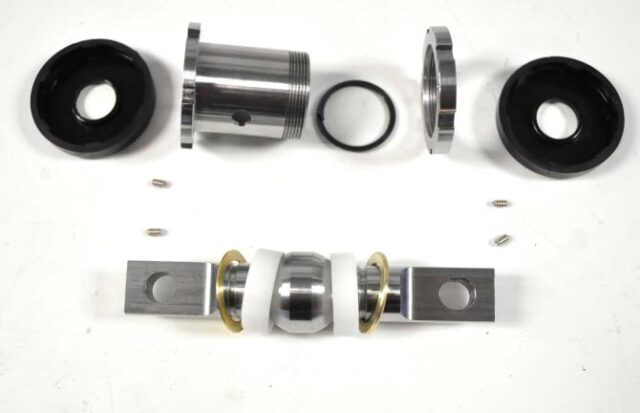
This design allow for lubrication via grease fitting, ball preload can be adjusted, presses directly into the control arm, is rebuild able, and comes with dust boots to keep the grease in and the dirt out. Another advantage is the shafts are offset. Offset shafts can increase or decrease caster or camber based on how you install the shaft. You can pretty much get whatever alignment you are looking for.
A shim kit is also included with the system so you can align the car.
Kit number — SMK-56 
The combination of these shims, lower lockout plates (LOC-56) and the offset shafts allow you to get a wide variety of alignment specs.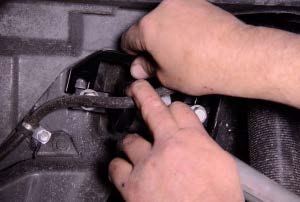
Summary:
This kit fixes the factory bushing system which causes vibrations and alignment issues when driving. This makes driving straight on an uneven road difficult and unstable. You might even feel a shutter in the front end of your Corvette. The KT-C56F bushing kit stabilizes the front end fixing alignment and deflection in the bushings so car will track straight through road irregularities.
This kit is used for:
- Street application
- Autocross
- Road racing
- Drag racing
- Solves alignment problems
- Eliminates vibrations do to rubber bushing problems
Corvette C5 and C6 Control Arm Bushing Kit Quality and Support
Quality is at the forefront of our mission at Global West, and our Corvette C5 and C6 replacement control arm bushing kit (Part Number: KT-C56F) exemplifies that commitment. Each component is meticulously crafted to enhance your vehicle’s performance and reliability, ensuring that your Corvette from 1997 to 2013 handles like a dream. We understand that upgrading your suspension can be daunting, which is why we provide comprehensive instruction sheets and engaging video tutorials to guide you through the installation process with ease. Our dedicated customer support team is always just a call or message away, ready to assist you with any questions or concerns you may have. Whether you’re tackling a street application, autocross, or road racing, you can trust that our products will deliver exceptional value and performance. Explore more options for your ride in our C5/C6 Corvette Parts or check out our C5/C6 Corvette Shims category for additional enhancements.


